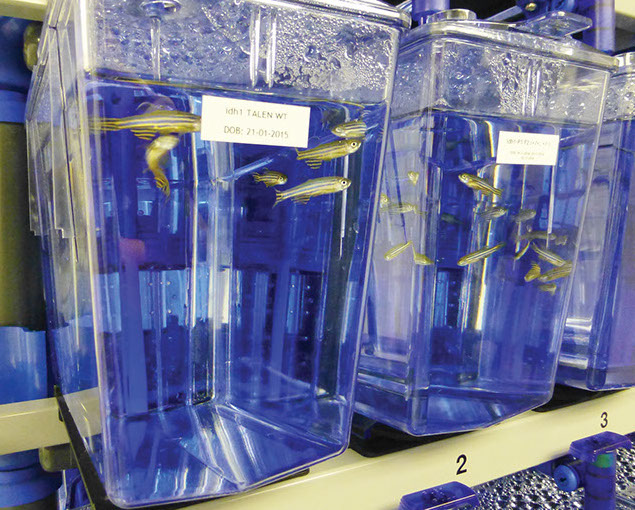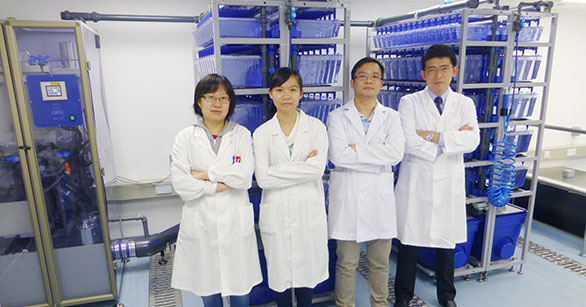Zebrafish Earn
Their Stripes
The Zebrafish Core Facility in Li Ka Shing Faculty of Medicine is proving an invaluable model for studying developmental biology and human diseases and is being used across multiple disciplines.
Extraction from pamphlets in 19th-century China illustrating children’s kidney being removed.
(Photo courtesy of Princeton Library)

In-house generated zebrafish mutants carrying mutation in idh1 gene (isocitrate dehydrogenase 1) for modelling of human leukaemia.


![]() Eighty per cent of genes identified in human genome can now be found in zebrafish. We can use them to study many human ailments, including cancers that have a genetic basis.
Eighty per cent of genes identified in human genome can now be found in zebrafish. We can use them to study many human ailments, including cancers that have a genetic basis.![]()
Professor Anskar Leung
The possibilities for the Core Facility all come down to one small fish, whose usefulness as a research tool has only been fully realised relatively recently. First used in the 1930s when scientists realised that the transparency of zebrafish embryos made them a perfect window for live study, modern zebrafish research started in the 1960s in Oregon when embryos were cloned. In 1996, two large-scale projects were undertaken in Germany and the United States – exposing zebrafish to chemicals that could induce mutation. Their usefulness as a vertebrate model for developmental biology was fully realised in 2013 when the entire genome of the zebrafish was published.
Professor Anskar Leung, Li Shu Fan Medical Foundation Professor in Haematology, Principal Coordinator of the Zebrafish Core Facility, explained: “Eighty per cent of genes identified in human genome can now be found in zebrafish. We can use them to study many human ailments, including cancers that have a genetic basis.
“The zebrafish model is compatible to a wide range of forward and reverse genetic manipulations. A phenotypic abnormality after chemical induced mutagenesis can be detected and traced to see how it has occurred. Technologies of gene knockdown and genome editing are also widely available and the effects of genetic alteration are visible under the microscopy.”
Professor Leung’s research focusses on the clinical management of patients with leukaemia and the development of novel therapy for these diseases. “We need to develop better treatments for leukaemia and better ways to test them, so the question we are asking is: Can the zebrafish model help us learn more about leukaemia and be used as a screening tool to identify new drugs?
“Leukaemia is a heterogeneous disease and each patient’s disease is unique. However, the current treatment is largely uniform and the outcome is expectedly unsatisfactory. We need to tailor-make a treatment for each patient at different stages of disease,” he said.
In the laboratory, the thinking is if the genetic defect causing the disease can be identified and recapitulated in zebrafish, the organisms can be used as a model to screen for better treatment. The zebrafish model is much faster, cheaper and easier than – and as close to human as – the mouse model. It is more relevant as a model of human diseases compared with cell line study.
The high fecundity and rapid embryonic development of zebrafish offer another advantage. “It’s a very timely model,” said Professor Leung. “We now have Next Generation Sequencing (NGS) technology, but the generation of genetic information has been so fast that it is difficult for us to validate them adequately in mouse models. The zebrafish model works fast enough to let us do that.”

Researchers from the Zebrafish Core Facility: (from left) Miss Guo Yuhan, Miss Toni Man, Dr Alvin Ma and
Professor Anskar Leung.
Key uses
The zebrafish is a key tool for people to understand numerous human diseases. Notable examples include blood diseases such as leukaemia and anaemia; neuro-degenerative diseases such as Parkinson’s and Alzheimer’s Disease, muscle diseases as well as hereditary or acquired kidney diseases. In particular, the nephron – the basic unit of the kidney – is remarkably similar in zebrafish and mammals.
“The zebrafish model can also be used to see how heart muscle can regenerate,” said Professor Leung. “If one removes part of the zebrafish heart muscle, it regenerates. Obviously this doesn’t happen in humans, but these experiments show how heart muscle can regenerate – how that process works – and that’s useful information.
“The model has also been used to study congenital defects that occur in infants. For example, to study disease conditions in which babies are born with their heart on the right side, researchers have been able to genetically modify the zebrafish so that they were born with similar defects.”
It is surprising to know that the zebrafish model has also been used to study psychiatric disorders. Professor Leung said: “Zebrafish swim in schools together a nd you can perturb this behaviour by changing their genes. The model has also provided good training opportunities. Recently we had a symposium at which research graduates from HKU and three other local universities gave talks on their research using the zebrafish model.”
HKU is not the only institution in Hong Kong to use zebrafish, but this is the first Core Facility provided by a faculty. “We want more people to use the facility,” said Professor Leung. “To date, nine research groups from different departments from within or outside the Faculty have joined the Core and produced research outputs (published in journals including Elife, Nature, Blood and the Journal of the American Chemical Society), and competitive funding proposals based on the zebrafish model have been successful.”
For more information, please go to http://www.med.hku.hk/corefac/zfcaboutus.htm

